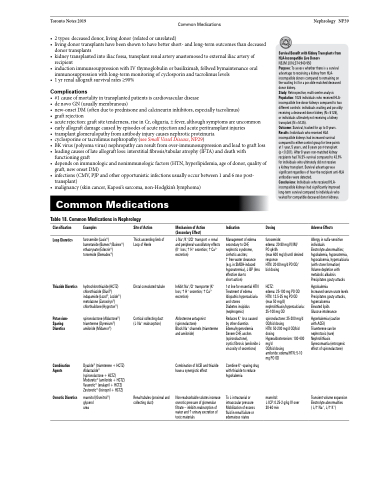Page 739 - TNFlipTest
P. 739
Toronto Notes 2019 Common Medications
• 2types:deceaseddonor,livingdonor(relatedorunrelated)
• livingdonortransplantshavebeenshowntohavebettershort-andlong-termoutcomesthandeceased
donor transplants
• kidneytransplantedintoiliacfossa,transplantrenalarteryanastomosedtoexternaliliacarteryof
recipient
• induction immunsouppression with IV thymoglobulin or basiliximab, follwed bymaintenance oral
immunosuppression with long-term monitoring of cyclosporin and tacrolimus levels
• 1yrrenalallograftsurvivalrates≥90%
Complications
• #1causeofmortalityintransplantedpatientsiscardiovasculardisease
• denovoGN(usuallymembranous)
• new-onsetDM(oftenduetoprednisoneandcalcineurininhibitors,especiallytacrolimus)
• graftrejection
• acute rejection: graft site tenderness, rise in Cr, oliguria, ± fever, although symptoms are uncommon
• early allograft damage caused by episodes of acute rejection and acute peritransplant injuries
• transplantglomerulopathyfromantibodyinjurycausesnephroticproteinuria
• cyclosporineortacrolimusnephropathy(seeSmallVesselDisease,NP29)
• BKvirus(polyomavirus)nephropathycanresultfromover-immunosuppressionandleadtograftloss • leading causes of late allograft loss: interstitial fibrosis/tubular atrophy (IFTA) and death with
functioning graft
• dependsonimmunologicandnonimmunologicfactors(HTN,hyperlipidemia,ageofdonor,qualityof
Nephrology NP39
graft, new onset DM)
• infections(CMV,PJPandotheropportunisticinfectionsusuallyoccurbetween1and6mopost-
Survival Benefit with Kidney Transplants from HLA-Incompatible Live Donors
NEJM 2016;374:940-950
Purpose: To assess whether there is a survival advantage to receiving a kidney from HLA- incompatible donors compared to remaining on the waiting list for a possible matched deceased donor kidney.
Study: Retrospective, multi-centre analysis Population: 1025 individuals who received HLA- incompatible live donor kidneys compared to two different controls: individuals waiting and possibly receiving a deceased donor kidney (N=5125),
or individuals ultimately not receiving a kidney transplant (N=5125).
Outcome: Survival, tracked for up to 8 years. Results: Individuals who received HLA incompatible kidneys had increased survival compared to either control group for time points at 1 year, 5 years, and 8 years post-transplant (p<0.001). After 8 years non-matched kidney recipients had 76.5% survival compared to 43.9% for individuals who ultimately did not receive
a kidney transplant. Survival advantage was significant regardless of how the recipient anti-HLA antibodies were detected.
Conclusions: Individuals who received HLA- incompatible kidneys had significantly improved long-term survival compared to individuals who waited for compatible deceased donor kidneys.
transplant)
• malignancy (skin cancer, Kaposi’s sarcoma, non-Hodgkin’s lymphoma)
Common Medications
Table 18. Common Medications in Nephrology
Classification
Loop Diuretics
Thiazide Diuretics
Potassium- Sparing Diuretics
Combination Agents
Osmotic Diuretics
Examples
furosemide (Lasix®) bumetanide (Bumex®/Buinex®) ethacrynate (Edecrin®) torsemide (Demadex®)
hydrochlorothiazide (HCTZ) chlorothiazide (Diuril®) indapamide (Lozol®, Lozide®) metolazone (Zaroxolyn®) chlorthalidone (Hygroton®)
spironolactone (Aldactone®) triamterene (Dyrenium®) amiloride (Midamor®)
Dyazide® (triamterene + HCTZ) Aldactazide®
(spironolactone + HCTZ) Moduretic® (amiloride + HCTZ) Vaseretic® (enalapril + HCTZ) Zestoretic® (lisinopril + HCTZ)
mannitol (Osmitrol®) glycerol
urea
Site of Action
Thick ascending limb of Loop of Henle
Distal convoluted tubule
Cortical collecting duct (Na+ reabsorption)
Renal tubules (proximal and collecting duct)
Mechanism of Action (Secondary Effect)
Na+/K+/2Cl– transport ±renal and peripheral vasodilatory effects (K+ loss;H+ secretion;Ca2+ excretion)
Inhibit Na+/Cl– transporter (K+ loss;H+ secretion;Ca2+ excretion)
Aldosterone antagonist (spironolactone)
Block Na+ channels (triamterene and amiloride)
Combination of ACEI and thiazide have a synergistic effect
Non-reabsorbable solutes increase osmotic pressure of glomerular filtrate – inhibits reabsorption of water andurinary excretion of toxic materials
Indication
Management of edema secondary to CHF, nephrotic syndrome, cirrhotic ascites;
free water clearance (e.g. in SIADH-induced hyponatremia), BP (less effective due to
short action)
1st line for essential HTN Treatment of edema Idiopathic hypercalciuria and stones
Diabetes insipidus (nephrogenic)
Reduces K+ loss caused by other diuretics Edema/hypervolemia Severe CHF, ascites (spironolactone),
cystic fibrosis (amiloride viscosity of secretions)
Combine K+-sparing drug with thiazide to reduce hypokalemia
Tointracranial or intraoccular pressure Mobilization of excess fluid in renal failure or edematous states
Dosing
furosemide:
edema: 20-80 mg IV/IM/
PO q6-8h
(max 600 mg/d) until desired response
HTN: 20-80 mg/d PO OD/ bid dosing
HCTZ:
edema: 25-100 mg PO OD HTN: 12.5-25 mg PO OD (max 50 mg/d) nephrolithiasis/hypercalciuria: 25-100 mg OD
spironolactone: 25-200 mg/d OD/bid dosing
HTN: 50-200 mg/d OD/bid dosing
Hyperaldosteronism: 100-400 mg/d
OD/bid dosing
amiloride: edema/HTN: 5-10 mg PO OD
mannitol:
ICP: 0.25-2 g/kg IV over 30-60 min
Adverse Effects
Allergy in sulfa-sensitive individuals
Electrolyte abnormalities; hypokalemia, hyponatremia, hypocalcemia, hypercalciuria (with stone formation) Volume depletion with metabolic alkalosis Precipitates gouty attacks
Hypokalemia
Increased serum urate levels Precipitates gouty attacks, hypercalcemia
Elevated lipids
Glucose intolerance
Hyperkalemia (caution with ACEI)
Triamterene can be nephrotoxic (rare) Nephrolithiasis Gynecomastia (estrogenic effect of spironolactone)
Transient volume expansion Electrolyte abnormalities
( / Na+, / K+)


